The Effect of Awareness-Raising on Household Water Consumption
Abstract
1. Introduction
2. Materials and Methods
3. Results and Discussion
4. Conclusions
Author Contributions
Funding
Institutional Review Board Statement
Informed Consent Statement
Data Availability Statement
Acknowledgments
Conflicts of Interest
References
- Kovats, R.S.; Valentini, R.; Bouwer, L.M.; Georgopoulou, E.; Jacob, D.; Martin, E.; Rounsevell, M.; Soussana, J.-F. Europe. In Climate Change 2014: Impacts, Adaptation, and Vulnerability Part B: Regional Aspects. Contribution of Working Group II to the Fifth Assessment Report of the Intergovernmental Panel on Climate Change; Barros, V.R., Field, C.B., Dokken, D.J., Mastrandrea, M.D., Mach, K.J., Bilir, T.E., Chatterjee, M., Ebi, K.L., Estrada, Y.O., Genova, R.C., et al., Eds.; Cambridge University Press: Cambridge, UK; New York, NY, USA, 2014; pp. 1267–1326. [Google Scholar]
- Bednar-Friedl, B.; Biesbroek, R.; Schmidt, D.N.; Alexander, P.; Børsheim, K.Y.; Carnicer, J.; Georgopoulou, E.; Haasnoot, M.; Le Cozannet, G.; Lionello, P.; et al. Europe. In Climate Change 2022: Impacts, Adaptation and Vulnerability. Contribution of Working Group II to the Sixth Assessment Report of the Intergovernmental Panel on Climate Change; Pörtner, H.-O., Roberts, D.C., Tignor, M., Poloczanska, E.S., Mintenbeck, K., Alegría, A., Craig, M., Langsdorf, S., Löschke, S., Möller, V., et al., Eds.; Cambridge University Press: Cambridge, UK; New York, NY, USA, 2022; pp. 1817–1927. [Google Scholar] [CrossRef]
- Stahl, K.; Hisdal, H.; Hannaford, J.; Tallaksen, L.M.; Van Lanen, H.A.J.; Sauquet, E.; Demuth, S.; Fendekova, M.; Jódar, J. Streamflow Trends in Europe: Evidence from a Dataset of near-Natural Catchments. Hydrol. Earth Syst. Sci. 2010, 14, 2367–2382. [Google Scholar] [CrossRef]
- Wilson, D.; Hisdal, H.; Lawrence, D. Has Streamflow Changed in the Nordic Countries?—Recent Trends and Comparisons to Hydrological Projections. J. Hydrol. 2010, 394, 334–346. [Google Scholar] [CrossRef]
- Petrow, T.; Merz, B. Aspects of Seasonality and FLood Generating Circulation Patterns in a Mountainous Catchment in South-Eastern Germany. Hydrol. Earth Syst. Sci. 2007, 11, 1455–1468. [Google Scholar] [CrossRef]
- Tu, M.; Hall, M.J.; De Laat, P.J.M.; De Wit, M.J.M. Extreme Floods in the Meuse River over the Past Century: Aggravated by Land-Use Changes? Phys. Chem. Earth Parts A/B/C 2005, 30, 267–276. [Google Scholar] [CrossRef]
- Villarini, G.; Smith, J.A.; Serinaldi, F.; Ntelekos, A.A. Analyses of Seasonal and Annual Maximum Daily Discharge Records for Central Europe. J. Hydrol. 2011, 399, 299–312. [Google Scholar] [CrossRef]
- Semenov, V.A. Climate-Related Changes in Hazardous and Adverse Hydrological Events in the Russian Rivers. Russ. Meteorol. Hydrol. 2011, 36, 124–129. [Google Scholar] [CrossRef]
- Renard, B.; Lang, M.; Bois, P.; Dupeyrat, A.; Mestre, O.; Niel, H.; Sauquet, E.; Prudhomme, C.; Parey, S.; Paquet, E.; et al. Regional Methods for Trend Detection: Assessing Field Significance and Regional Consistency. Water Resour. Res. 2008, 44, W08419. [Google Scholar] [CrossRef]
- Yiou, P.; Ribereau, P.; Naveau, P.; Nogaj, M.; Brázdil, R. Statistical Analysis of Floods in Bohemia (Czech Republic) since 1825. Hydrol. Sci. J. 2006, 51, 930–945. [Google Scholar] [CrossRef]
- Bormann, H.; Pinter, N.; Elfert, S. Hydrological Signatures of Flood Trends on German Rivers: Flood Frequencies, Flood Heights and Specific Stages. J. Hydrol. 2011, 404, 50–66. [Google Scholar] [CrossRef]
- Settele, J.; Scholes, R.; Betts, R.; Bunn, S.; Leadley, P.; Nepstad, D.; Overpeck, J.T.; Taboada, M.A. Terrestrial and inland water systems. In Climate Change 2014: Impacts, Adaptation, and Vulnerability. Part A: Global and Sectoral Aspects. Contribution of Working Group II to the Fifth Assessment Report of the Intergovernmental Panel on Climate Change; Cambridge Press: Cambridge, UK; New York, NY, USA, 2014; pp. 271–359. [Google Scholar]
- Dankers, R.; Feyen, L. Climate Change Impact on Flood Hazard in Europe: An Assessment Based on High-resolution Climate Simulations. J. Geophys. Res. 2008, 113, D19105. [Google Scholar] [CrossRef]
- Rojas, R.; Feyen, L.; Bianchi, A.; Dosio, A. Assessment of Future Flood Hazard in Europe Using a Large Ensemble of Bias-corrected Regional Climate Simulations. J. Geophys. Res. 2012, 117, D17109. [Google Scholar] [CrossRef]
- Gao, X.; Giorgi, F. Increased Aridity in the Mediterranean Region under Greenhouse Gas Forcing Estimated from High Resolution Simulations with a Regional Climate Model. Glob. Planet. Change 2008, 62, 195–209. [Google Scholar] [CrossRef]
- Tsanis, I.K.; Koutroulis, A.G.; Daliakopoulos, I.N.; Jacob, D. Severe Climate-Induced Water Shortage and Extremes in Crete: A Letter. Clim. Change 2011, 106, 667–677. [Google Scholar] [CrossRef]
- Wong, W.K.; Beldring, S.; Engen-Skaugen, T.; Haddeland, I.; Hisdal, H. Climate Change Effects on Spatiotemporal Patterns of Hydroclimatological Summer Droughts in Norway. J. Hydrometeorol. 2011, 12, 1205–1220. [Google Scholar] [CrossRef]
- Essa, Y.H.; Hirschi, M.; Thiery, W.; El-Kenawy, A.M.; Yang, C. Drought characteristics in Mediterranean under future climate change. npj Clim. Atmos. Sci. 2023, 6, 133. [Google Scholar] [CrossRef]
- Grillakis, M.G. Increase in severe and extreme soil moisture droughts for Europe under climate change. Sci. Total Environ. 2019, 660, 1245–1255. [Google Scholar] [CrossRef]
- Gaona, J.; Bavera, D.; Fioravanti, G.; Hahn, S.; Stradiotti, P.; Filippucci, P.; Camici, S.; Ciabatta, L.; Mosaffa, H.; Puca, S.; et al. Soil moisture product consistency for operational drought monitoring in Europe. Hydrol. Earth Syst. Sci. 2025, 29, 3865–3888. [Google Scholar] [CrossRef]
- Seneviratne, S.I.; Nicholls, N.; Easterling, D.; Goodess, C.M.; Kanae, S.; Kossin, J.; Luo, Y.; Marengo, J.; McInnes, K.; Rahimi, M.; et al. Changes in climate extremes and their impacts on the natural physical environment. In Managing the Risks of Extreme Events and Disasters to Advance Climate Change Adaptation. A Special Report of Working Groups I and II of the Intergovernmental Panel on Climate Change; Cambridge University Press: Cambridge, UK; New York, NY, USA, 2012; pp. 109–230. [Google Scholar]
- Handmer, J.Y.; Honda, Z.W.; Kundzewicz, N.; Arnell, G.; Benito, J.; Hatfield, I.F.; Mohamed, P.; Peduzzi, S.; Wu, B.; Sherstyukov, B.; et al. Changes in Impacts of Climate Extremes: Human Systems and Ecosystems. In Managing the Risks of Extreme Events and Disasters to Advance Climate Change Adaptation; Cambridge University Press: Cambridge, UK; New York, NY, USA, 2012; pp. 231–290. [Google Scholar]
- Visser, H.; Petersen, A.C.; Ligtvoet, W. On the Relation between Weather-Related Disaster Impacts, Vulnerability and Climate Change. Clim. Change 2014, 125, 461–477. [Google Scholar] [CrossRef]
- Hoegh-Guldberg, O.; Jacob, D.; Taylor, M.; Bindi, M.; Brown, S.; Camilloni, I.; Diedhiou, A.; Djalante, R.; Ebi, K.L.; Engelbrecht, F.; et al. Impacts of 1.5 °C Global Warming on Natural and Human Systems. In Global Warming of 1.5 °C. An IPCC Special Report on the Impacts of Global Warming of 1.5 °C Above Pre-Industrial Levels and Related Global Greenhouse Gas Emission Pathways, in the Context of Strengthening the Global Response to the Threat of Climate Change, Sustainable Development, and Efforts to Eradicate Poverty. Masson-Delmotte, V.; Zhai, P., Pörtner, H.-O., Roberts, D., Skea, J., Shukla, P.R., Pirani, A., Moufouma-Okia, W., Péan, C., Pidcock, R., et al., Eds.; Cambridge University Press: Cambridge, UK; New York, NY, USA, 2018; pp. 175–311. [Google Scholar]
- Merz, B.; Blöschl, G.; Vorogushyn, S.; Dottori, F.; Aerts, J.C.J.H.; Bates, P.; Bertola, M.; Kemter, M.; Kreibich, H.; Lall, U.; et al. Causes, Impacts and Patterns of Disastrous River Floods. Nat. Rev. Earth Environ. 2021, 2, 592–609. [Google Scholar] [CrossRef]
- Dari, J.; Flammini, A.; Morbidelli, R.; Saltalippi, C. Evolution of Freshwater Availability in a Climate-changing Mediterranean Context: The case of Umbria region, central Italy. Hydrol. Process. 2023, 37, e15050. [Google Scholar] [CrossRef]
- Rahi, A.; Rahmati, M.; Dari, J.; Saltalippi, C.; Brogi, C.; Morbidelli, R. Unraveling hydroclimatic forces controlling the runoff coefficient trends in central Italy’s Upper Tiber Basin. J. Hydrol. Reg. Stud. 2023, 50, 101579. [Google Scholar] [CrossRef]
- Stahl, K.; Tallaksen, L.M.; Hannaford, J.; van Lanen, H.A.J. Filling the white space on maps of European runoff trends: Estimates from a multi-model ensemble. Hydrol. Earth Syst. Sci. 2012, 16, 2035–2047. [Google Scholar] [CrossRef]
- Masseroni, D.; Camici, S.; Cislaghi, A.; Vacchiano, G.; Massari, C.; Brocca, L. The 63-year changes in annual streamflow volumes across Europe with a focus on the Mediterranean basin. Hydrol. Earth Syst. Sci. 2021, 25, 5589–5601. [Google Scholar] [CrossRef]
- Piao, S.; Ciais, P.; Huang, Y.; Shen, Z.; Peng, S.; Li, J.; Zhou, L.; Liu, H.; Ma, Y.; Ding, Y.; et al. The Impacts of Climate Change on Water Resources and Agriculture in China. Nature 2010, 467, 43–51. [Google Scholar] [CrossRef]
- Jones, J.A. Hydrologic Responses to Climate Change: Considering Geographic Context and Alternative Hypotheses. Hydrol. Process. 2011, 25, 1996–2000. [Google Scholar] [CrossRef]
- Dai, A. Increasing Drought under Global Warming in Observations and Models. Nat. Clim. Change 2013, 3, 52–58. [Google Scholar] [CrossRef]
- Jiménez Cisneros, B.E.; Oki, T.; Arnell, N.W.; Benito, G.; Cogley, J.G.; Döll, P.; Jiang, T.; Mwakalila, S.S. Freshwater resources. In Climate Change 2014: Impacts, Adaptation, and Vulnerability. Part A: Global and Sectoral Aspects. Contribution of Working Group II to the Fifth Assessment Report of the Intergovernmental Panel on Climate Change; Cambridge University Press: Cambridge, UK; New York, NY, USA, 2014; pp. 229–269. [Google Scholar]
- Dari, J.; Quintana-Seguí, P.; Barella-Ortiz, A.; Rahmati, M.; Saltalippi, C.; Flammini, A.; Brocca, L. Quantifying the Hydrological Impacts of Irrigation on a Mediterranean Agricultural Context Through Explicit Satellite-Derived Irrigation Estimates. Water Resour. Res. 2024, 60, e2023WR036510. [Google Scholar] [CrossRef]
- Taylor, I.H.; Burke, E.; McColl, L.; Falloon, P.D.; Harris, G.R.; McNeall, D. The Impact of Climate Mitigation on Projections of Future Drought. Hydrol. Earth Syst. Sci. 2013, 17, 2339–2358. [Google Scholar] [CrossRef]
- Bhattarai, N.; Pollack, A.; Lobell, D.B.; Fishman, R.; Singh, B.; Dar, A.; Jain, M. The impact of groundwater depletion on agricultural production in India. Environ. Res. Lett. 2021, 16, 085003. [Google Scholar] [CrossRef]
- Dari, J.; Filippucci, P.; Brocca, L.; Quast, R.; Vreugdenhil, M.; Miralles, D.G.; Morbidelli, R.; Saltalippi, C.; Flammini, A. A novel approach for estimating groundwater recharge leveraging high-resolution satellite soil moisture. J. Hydrol. 2025, 652, 132678. [Google Scholar] [CrossRef]
- Feng, W.; Zhong, M.; Lemoine, J.-M.; Biancale, R.; Hsu, H.-T.; Xia, J. Evaluation of groundwater depletion in North China using theGravity Recovery and Climate Experiment (GRACE) data andground-based measurements. Water Resour. Res. 2013, 49, 2110–2118. [Google Scholar] [CrossRef]
- Famiglietti, J.S. The global groundwater crisis. Nat. Clim. Chang. 2014, 4, 945–948. [Google Scholar] [CrossRef]
- Brocca, L.; Barbetta, S.; Camici, S.; Ciabatta, L.; Dari, J.; Filippucci, P.; Massari, C.; Modanesi, S.; Tarpanelli, A.; Bonaccorsi, B.; et al. A Digital Twin of the terrestrial water cycle: A glimpse into the future through high-resolution Earth observations. Front. Sci. 2024, 1, 1190191. [Google Scholar] [CrossRef]
- Camici, S.; Dari, J.; Filippucci, P.; Massari, C.; Avanzi, F.; Delogu, F.; Baez-Villanueva, O.M.; Vreugdenhil, M.; Volden, E.; Fernandez-Prieto, D.; et al. High-resolution satellite observations for developing advanced decision support systems for water resources management in the Po River. J. Hydrol. 2025, 662, 134047. [Google Scholar] [CrossRef]
- Broering, L.A.; Michel, J.; Henning, E.; Konrath, A.C. An investigation into water consumption by university students: Actions, beliefs and perceptions. Discov. Water 2024, 4, 114. [Google Scholar] [CrossRef]
- Harriden, K. Water Diaries: Generate intra-household water use data—Generate water use behaviour change. J. Water Sanit. Hyg. Dev. 2013, 3, 70–80. [Google Scholar] [CrossRef]
- Morote, Á.-F.; Hernández, M.; Olcina, J.; Rico, A.-M. Water Consumption and Management in Schools in the City of Alicante (Southern Spain) (2000–2017): Free Water Helps Promote Saving Water? Water 2020, 12, 1052. [Google Scholar] [CrossRef]
- Nayar, A.; Kanaka, S. Nudging urban water conservation:evidence from India on the effect of behavior economics on water consumption. Eur. J. Res. Soc. Sci. 2017, 5, 73–84. [Google Scholar]
- Miranda, J.J.; Datta, S.; Zoratto, L. Saving Water with a Nudge (or Two): Evidence from Costa Rica on the Effectiveness and Limits of Low-Cost Behavioral Interventions on Water Use. World Bank Econ. Rev. 2020, 34, 444–463. [Google Scholar] [CrossRef]
- Bich-Ngoc, N.; Prevedello, C.; Cools, M.; Teller, J. Factors Influencing Residential Water Consumption in Wallonia, Belgium. Util. Policy 2022, 74, 101281. [Google Scholar] [CrossRef]
- Jorgensen, B.S.; Martin, J.F.; Pearce, M.W.; Willis, E.M. Predicting Household Water Consumption With Individual-Level Variables. Environ. Behav. 2014, 46, 872–897. [Google Scholar] [CrossRef]
- Dias, T.F.; Kalbusch, A.; Henning, E. Factors Influencing Water Consumption in Buildings in Southern Brazil. J. Clean. Prod. 2018, 184, 160–167. [Google Scholar] [CrossRef]
- Lu, S.; Gao, X.; Li, W.; Jiang, S.; Huang, L. A Study on the Spatial and Temporal Variability of the Urban Residential Water Consumption and Its Influencing Factors in the Major Cities of China. Habitat Int. 2018, 78, 29–40. [Google Scholar] [CrossRef]
- Figueiredo, M.; Fernandes, A.; Neves, J.; Vicente, H. Sustainable Water Use and Public Awareness in Portugal. Sustainability 2024, 16, 5444. [Google Scholar] [CrossRef]
- Boca, G.D.; Saraçlı, S. Environmental Education and Student’s Perception, for Sustainability. Sustainability 2019, 11, 1553. [Google Scholar] [CrossRef]
- Hajj-Hassan, M.; Chaker, R.; Cederqvist, A.-M. Environmental Education: A Systematic Review on the Use of Digital Tools for Fostering Sustainability Awareness. Sustainability 2024, 16, 3733. [Google Scholar] [CrossRef]
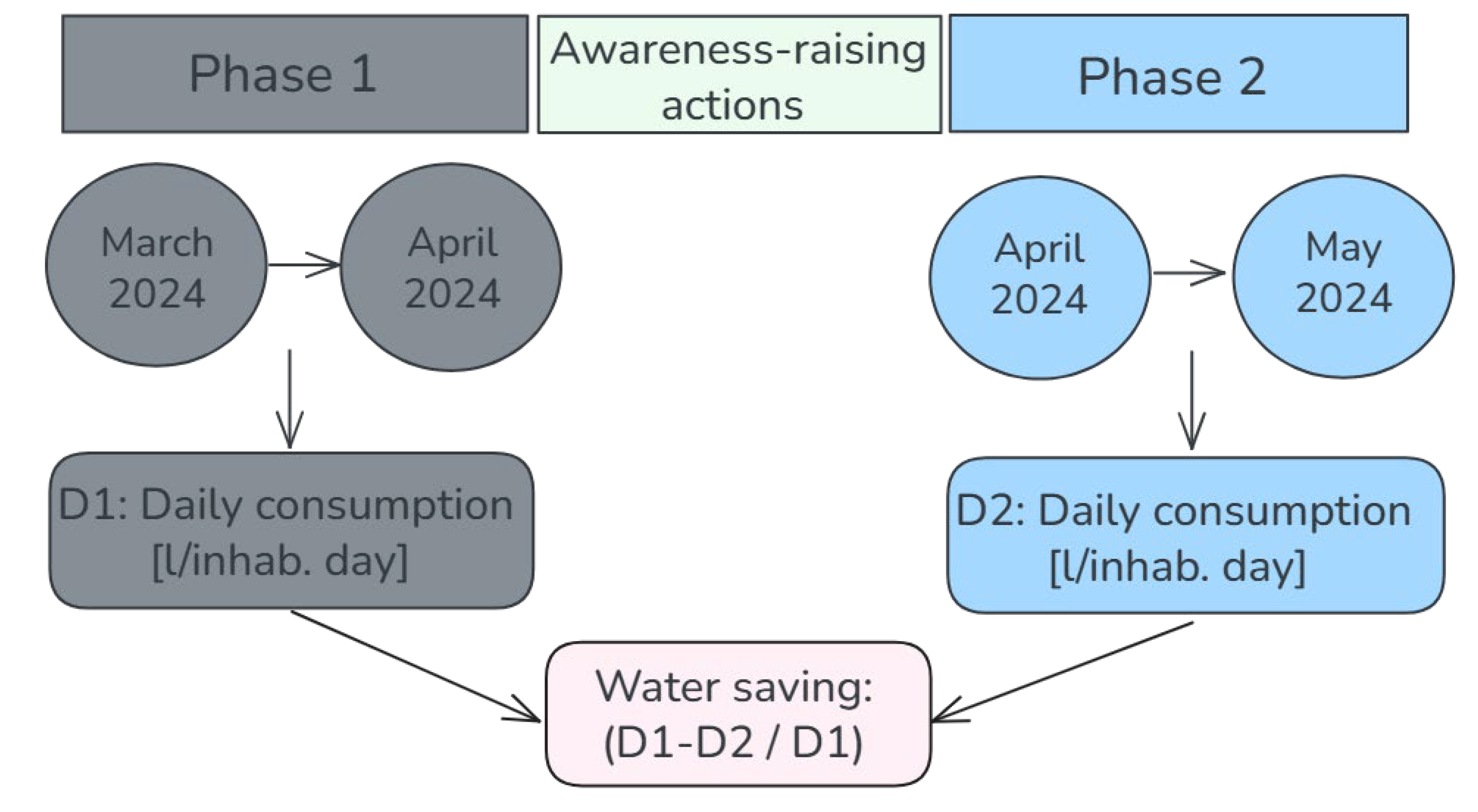
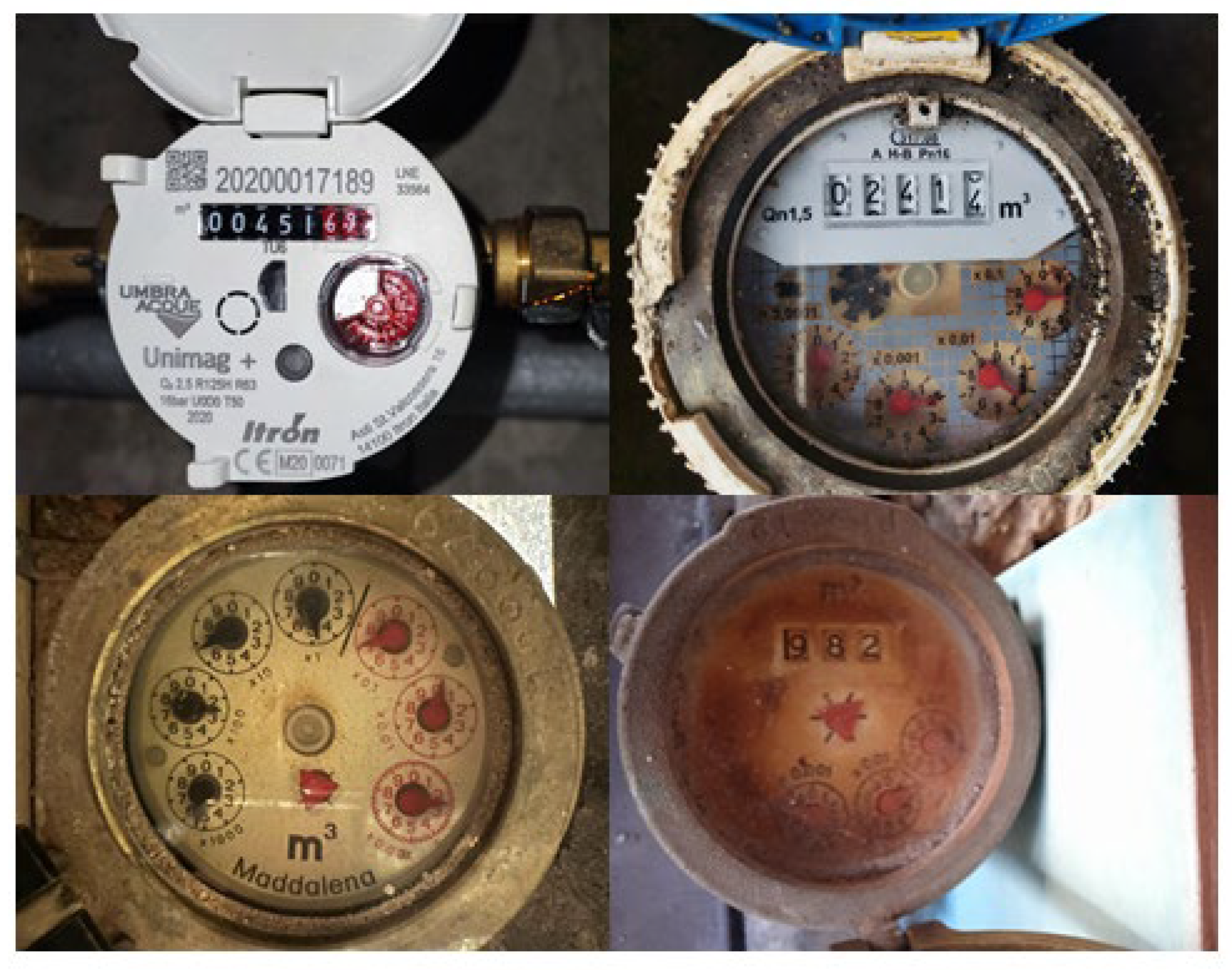
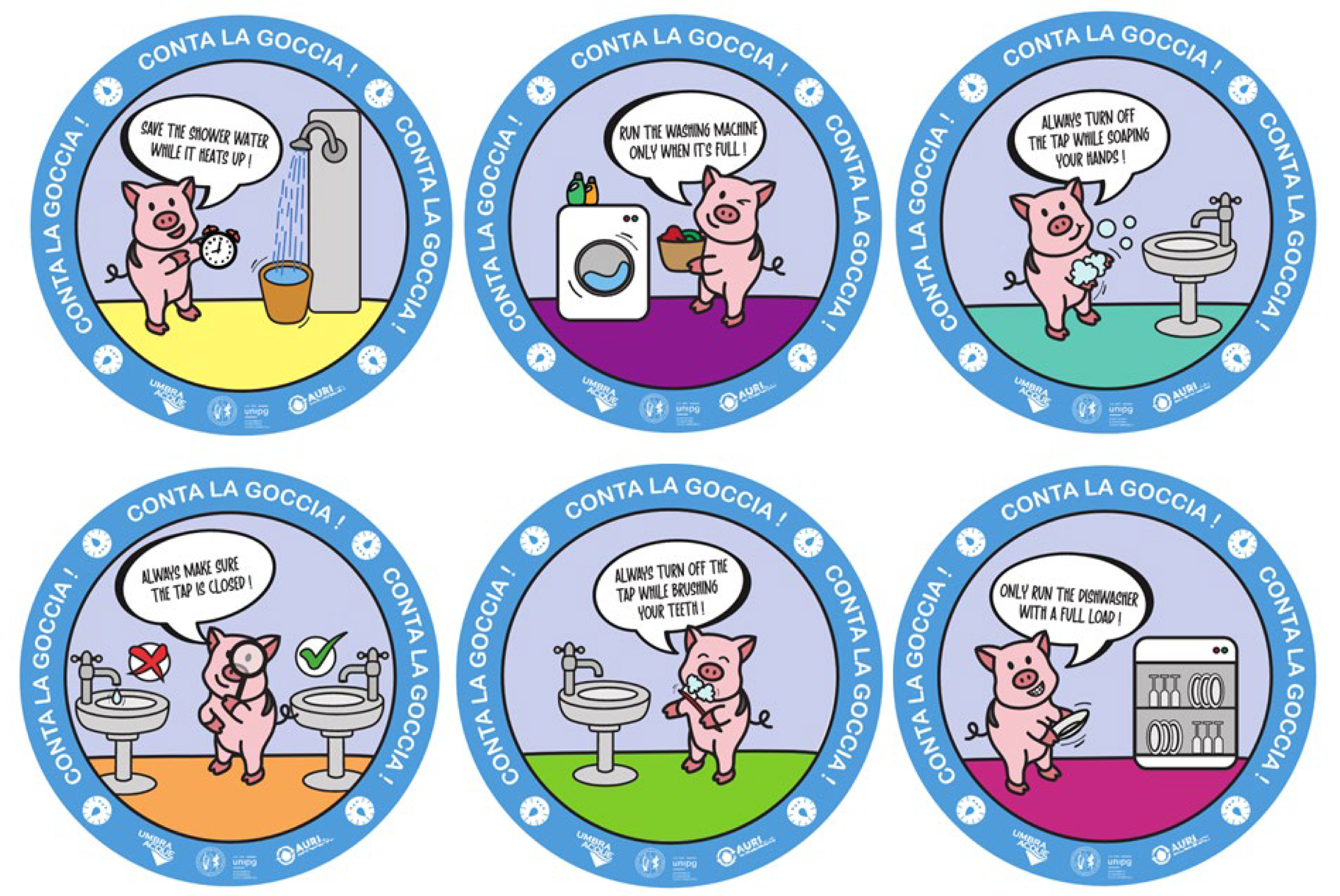
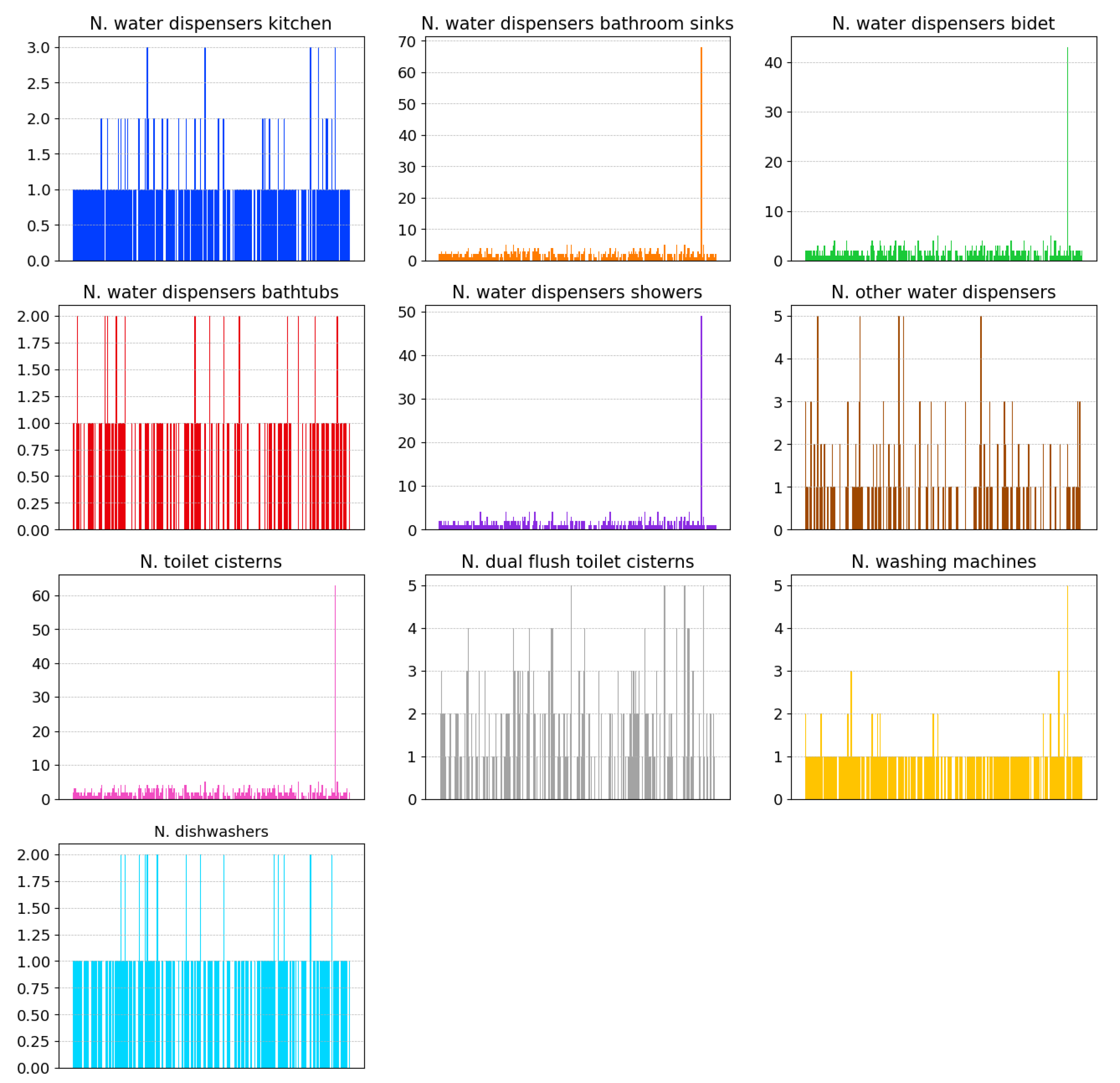

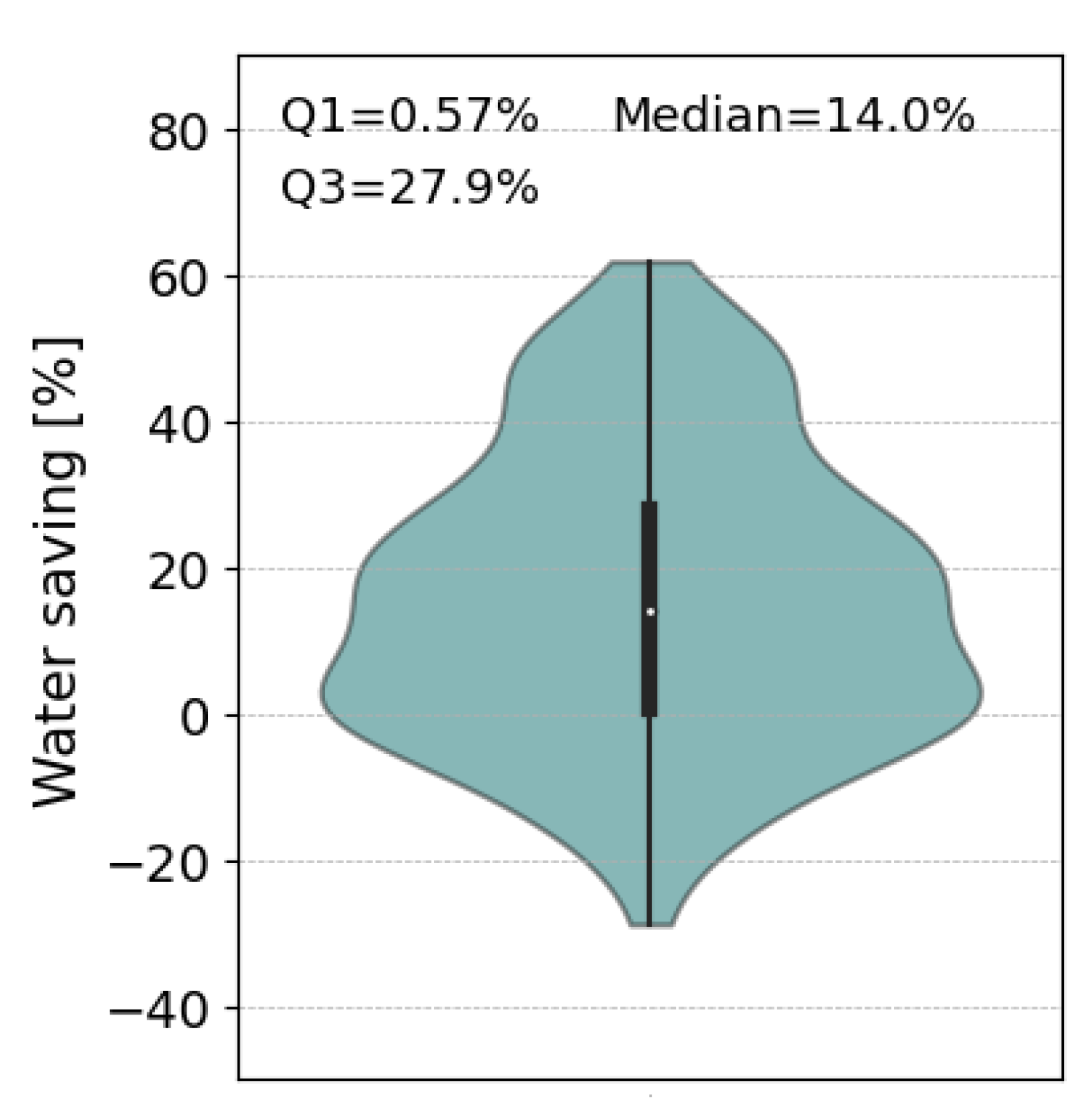

Disclaimer/Publisher’s Note: The statements, opinions and data contained in all publications are solely those of the individual author(s) and contributor(s) and not of MDPI and/or the editor(s). MDPI and/or the editor(s) disclaim responsibility for any injury to people or property resulting from any ideas, methods, instructions or products referred to in the content. |
© 2025 by the authors. Licensee MDPI, Basel, Switzerland. This article is an open access article distributed under the terms and conditions of the Creative Commons Attribution (CC BY) license (https://creativecommons.org/licenses/by/4.0/).
Share and Cite
Morbidelli, R.; Saltalippi, C.; Flammini, A.; Dari, J. The Effect of Awareness-Raising on Household Water Consumption. Sustainability 2025, 17, 8887. https://doi.org/10.3390/su17198887
Morbidelli R, Saltalippi C, Flammini A, Dari J. The Effect of Awareness-Raising on Household Water Consumption. Sustainability. 2025; 17(19):8887. https://doi.org/10.3390/su17198887
Chicago/Turabian StyleMorbidelli, Renato, Carla Saltalippi, Alessia Flammini, and Jacopo Dari. 2025. "The Effect of Awareness-Raising on Household Water Consumption" Sustainability 17, no. 19: 8887. https://doi.org/10.3390/su17198887
APA StyleMorbidelli, R., Saltalippi, C., Flammini, A., & Dari, J. (2025). The Effect of Awareness-Raising on Household Water Consumption. Sustainability, 17(19), 8887. https://doi.org/10.3390/su17198887








